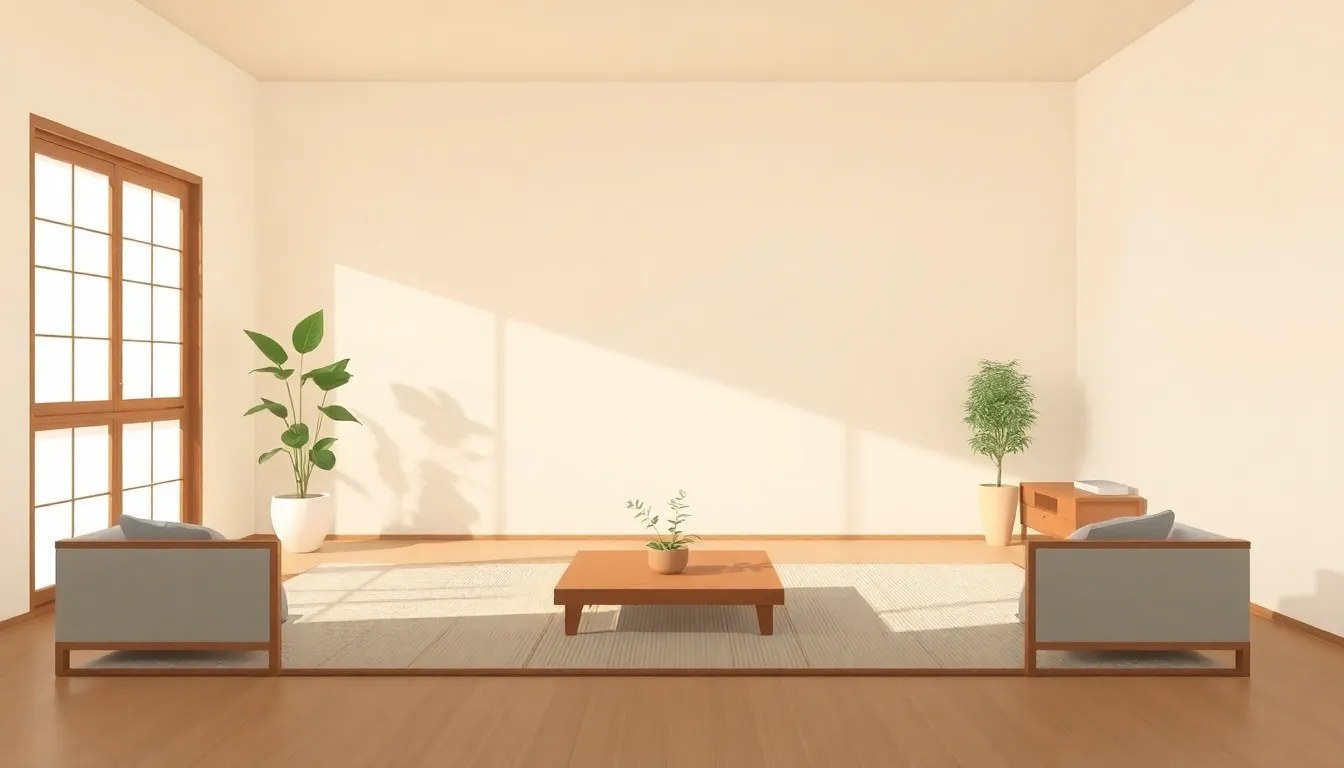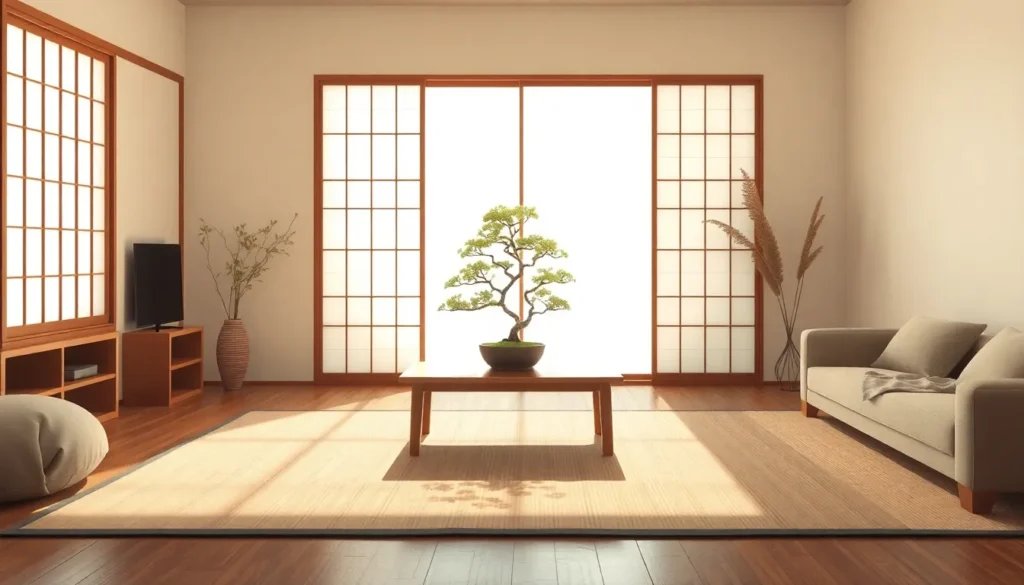Table of Contents
TogglePicture this: a living room so serene it could make a monk jealous. Japanese minimalist living rooms blend simplicity and elegance, creating spaces that feel both tranquil and stylish. With their clean lines and uncluttered aesthetics, these rooms invite relaxation and foster a sense of calm, making them the perfect antidote to today’s chaotic world.
Overview of Japanese Minimalist Living Room
Japanese minimalist living rooms embody tranquility and simplicity. Clean lines dominate the design, fostering a sense of calm. Clutter-free spaces enhance relaxation, making them ideal for unwinding after a hectic day. Natural materials like wood and bamboo contribute warmth and connect indoor spaces with nature.
Furniture selection is intentional, focusing on multi-functional pieces. Low seating options, such as tatami mats or low tables, promote a closer connection to the ground. This encourages an appreciation for simplicity and functionality. Light colors and neutral palettes further enhance the serene atmosphere.
Consider incorporating sliding doors, known as fusuma, which allow for flexible room layouts. These elements not only save space but also maintain a seamless flow between areas. Plants and subtle decor complement the aesthetic without overwhelming the senses.
Each element serves a purpose, emphasizing minimalism. Open space is crucial, allowing for breathing room and visual clarity. Selecting fewer, high-quality items promotes meaningful interactions with the environment. Overall, these qualities create a balanced atmosphere that encourages mindfulness and reflection.
Key Elements of Japanese Minimalist Design

Japanese minimalist design emphasizes simplicity and purpose. Each element contributes to a serene atmosphere that promotes relaxation.
Simplicity and Functionality
Whitespace dominates in Japanese minimalist living rooms. Open layouts utilize minimal furniture, focusing on essential items. Multi-functional pieces provide versatility, such as a sofa that converts into a bed. Low seating enhances comfort while encouraging a grounded connection to the space. Minimal decorations keep distractions at bay, allowing for clarity and mindfulness. Intentional design choices highlight the importance of functionality, ensuring every object serves a distinct role.
Natural Materials
Natural materials form the backbone of Japanese design principles. Wood and bamboo create warmth and invite the outdoors inside. These elements reinforce a bond with nature, enhancing the overall tranquil environment. Textures play a crucial role; tatami mats provide soft underfoot comfort. Stone accents can introduce subtle elegance while maintaining an organic feel. Each material connects to the overarching theme of harmony, blending seamlessly with the overall design.
Neutral Color Palette
A muted color palette defines the aesthetic of Japanese minimalist living rooms. Soft whites, beiges, and earthy tones create a calm and inviting atmosphere. This choice of colors reinforces space perception, making areas feel larger and more open. Light colors reflect natural light, enhancing overall brightness in the room. Pops of color can emerge through carefully chosen plants or artwork, providing minimal yet impactful contrasts. Each shade works together to maintain tranquility while fostering a sense of balance.
Furniture Choices for a Japanese Minimalist Living Room
Japanese minimalist living rooms prioritize furniture that emphasizes simplicity and openness. Thoughtful selections enhance relaxation and maintain a serene environment.
Low-profile Furniture
Low-profile furniture defines the aesthetic of Japanese minimalist living rooms. This type of furniture encourages an unobtrusive presence, allowing the room to feel spacious. Often found are low tables, futons, and tatami mats that create a grounded atmosphere. Such furnishings maintain a clean line and draw attention to the room’s expansive feel. Choosing natural finishes complements the serene vibe, blending seamlessly with other elements. Overall, low-profile choices foster an inviting environment that encourages calmness and mindfulness.
Multi-functional Pieces
Multi-functional pieces play a crucial role in Japanese minimalist design. Convertible sofas or storage ottomans provide versatility while minimizing visual clutter. These items adapt to various needs, whether serving as seating, beds, or storage solutions. Functional designs support a fluid lifestyle, allowing easy transitions between activities. Selecting pieces with hidden storage keeps essentials organized without disrupting the aesthetic. With multi-functional furniture, spaces remain open and functional, enhancing overall tranquility.
Incorporating Nature in Design
Incorporating nature into Japanese minimalist living rooms enhances serenity and tranquility. Key elements like tatami mats and shoji screens play vital roles in this design approach.
Tatami Mats and Shoji Screens
Tatami mats provide a natural flooring option, fostering a warm and inviting atmosphere. These mats are made from rice straw, contributing to air quality and comfort. Shoji screens, on the other hand, enhance privacy while allowing soft, diffused light to filter through. Designers often use shoji screens to create flexible room divisions, maintaining a sense of openness. Not only do these elements connect the interior space to nature, but they also emphasize simplicity and functionality, hallmarks of Japanese minimalist design. Together, tatami mats and shoji screens cultivate a peaceful environment, encouraging reflection and relaxation.
Indoor Plants and Natural Light
Introducing indoor plants invigorates living spaces while reinforcing the connection to nature. Plants such as bonsai trees or succulents add life and vibrancy, enhancing the overall aesthetic. Natural light is equally important; large windows or strategically placed openings invite sunlight, illuminating the room with warmth. Light wood finishes paired with plants create a harmonious balance, promoting mindfulness and clarity. Emphasizing both greenery and light fosters a healthy environment that encourages well-being. Incorporating these elements transforms a living room into a tranquil retreat, making it an ideal space for relaxation and rejuvenation.
Tips for Creating Your Own Japanese Minimalist Living Room
Creating a Japanese minimalist living room requires intent and focus. Each element should serve a purpose while maintaining simplicity.
Decluttering and Organization
Start by assessing belongings and removing excess items. Keep only what’s necessary and meaningful, ensuring a clean and spacious environment. Utilize storage solutions that blend seamlessly with the design, such as low cabinets or baskets made from natural materials. Design spaces for easy access to items, minimizing visual clutter. Maintain symmetry and balance through thoughtful placement of furniture. Regularly evaluate your space and adjust as needed to keep the room tranquil and organized.
Personal Touches in Minimalism
Incorporating personal touches adds warmth without overwhelming simplicity. Display a few curated art pieces or photographs that resonate with your experiences. Choose decorative items made from natural materials, such as stone or wood, which align with the overall aesthetic. Include a single statement plant, like a bonsai tree, to bring life into the room. Natural light enhances the ambiance, so choose window treatments carefully to maximize brightness. Thoughtful details create a sense of belonging while adhering to minimalist principles.
Embracing Japanese minimalist living room design transforms spaces into serene retreats. By prioritizing simplicity and functionality, individuals can create environments that promote relaxation and mindfulness. The careful selection of multi-functional furniture and natural materials fosters a connection to nature while maintaining a clean aesthetic.
Incorporating elements like tatami mats and shoji screens enhances both comfort and tranquility. Adding indoor plants and maximizing natural light further invigorates the space, creating a harmonious balance. With thoughtful organization and intentional design, anyone can cultivate a Japanese minimalist living room that serves as a peaceful escape from the chaos of daily life.








